This summer, eight students in the Biomolecular Engineering, Science, and Technology study abroad program in Lyon, France (BEST-Lyon) were able to explore the rich cultural, scientific, and economic history of silk production in the city in an unlikely place: a biology lab.
A visit to any new country would be incomplete without exploring the local culture and history. This summer, eight Georgia Tech students did some of their exploring of Lyon, France in an unlikely place: a biology lab.
The biology, neuroscience, and biochemistry undergraduates were enrolled in a special offering of the Cell and Molecular Biology Laboratory (BIOS 3451) as part of the Georgia Tech Biomolecular Engineering, Science, and Technology study abroad program in Lyon (BEST-Lyon). As it was the first time the lab was offered as part of the program, the instructors took the budding course as an opportunity to try something new, aiming to mesh the lab with the local culture surrounding them while abroad. And for Lyon, that meant incorporating silk.
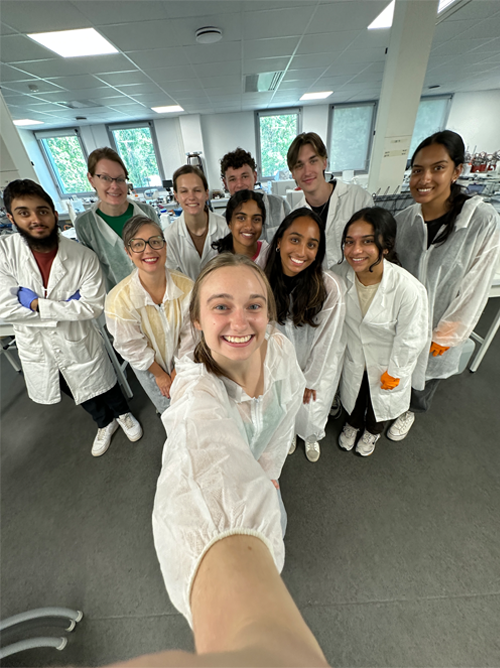
The students and instructors and some of the students in the BEST-Lyon program. Back (left to right): Ebrahim Faizullabhoy, Alison Onstine, Reagan Hicks, Aaron Thompson, Shaun Deedy, Darsha Krishnamurthi. Middle: Jennifer Leavey, Manasi Oleti, Kareena Desai, Sonali Patel. Front: Anna Gibbs. (Photo: Anna Gibbs)
An interwoven legacy
“Silk is integral to the history of Lyon,” says Jennifer Leavey, principal academic professional in the School of Biological Sciences, assistant dean for Faculty Mentoring in the College of Sciences, and one of the co-instructors for the course. Since it was introduced to Lyon in the 1400’s, silk production and the silk trade have been a driving force of the city’s culture and economy, growing even more with the industrialization of the process in the 19th century. “Lyon grew up because of the silk trade and the looms for jacquard silk that were invented in Lyon.”
The institution hosting the BEST-Lyon program itself — CPE Lyon (École Supérieure de Chimie Physique Électronique de Lyon), a graduate school specializing in chemical engineering — grew out of the chemical industry brought by the silk trade. As CPE Lyon is “intimately linked to the history of silk production in this region of France,” says Heidi Böhnert, silkworms were the perfect topic for the new lab course ”since it connects with the history of Lyon, the history of CPE and biotechnology, even microbiology.” Böhnert is the director of International Relations and head of Life Sciences and Biotechnology at CPE Lyon.
Wanting to honor that legacy, Leavey and her co-instructor Alison Onstine, a laboratory manager in the School of Biological Sciences, decided to use silkworms as the model organism for the lab. “We've never taught a cell molecular biology lab on one of the study abroad programs before,” says Onstine, “so, I think this was such an interesting opportunity for us to work in this local angle.”
To prepare the course, the instructors worked with recent alumna Danielle Jones (BCHEM '23) during the Spring semester to develop and troubleshoot research methods for students to use on the silkworms while abroad. Meanwhile, they coordinated with the staff of CPE Lyon to ensure everything would be ready for the student’s arrival. CPE offered their enthusiastic support, raising silkworms from eggs that were donated to the program by Maison Brochier Soieries, a silk atelier in Lyon that has been in business since 1890. The worms were fed fresh mulberry leaves collected from trees on the University of Lyon campus.
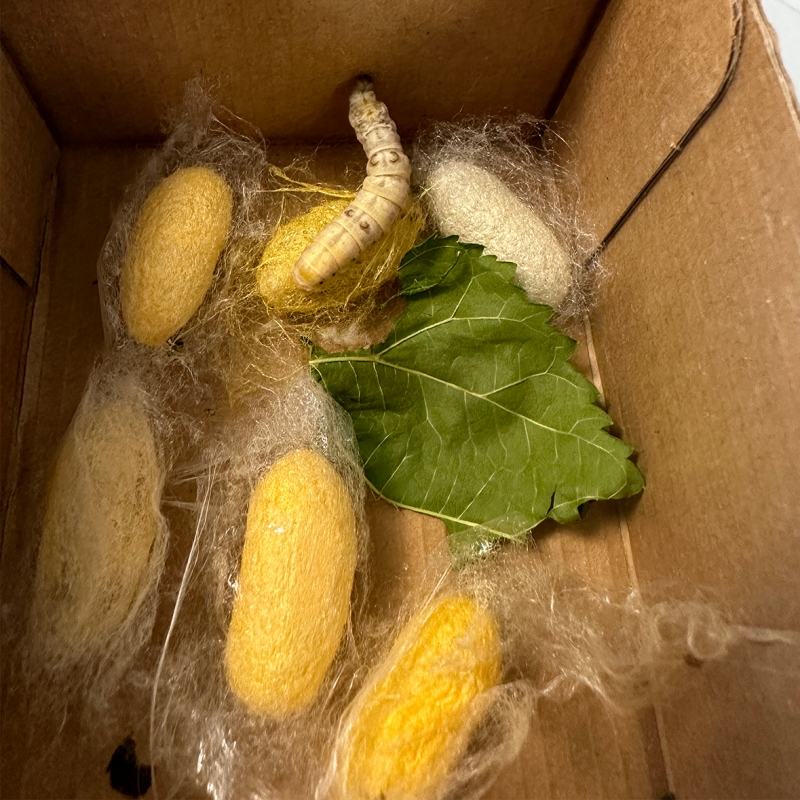
The silk worms and their cocoons. Many of the students were interested in why the cocoons — which are made comprised primarily of the silk proteins used to create silk fabric — were different colors. (Photo: Jennifer Leavey)
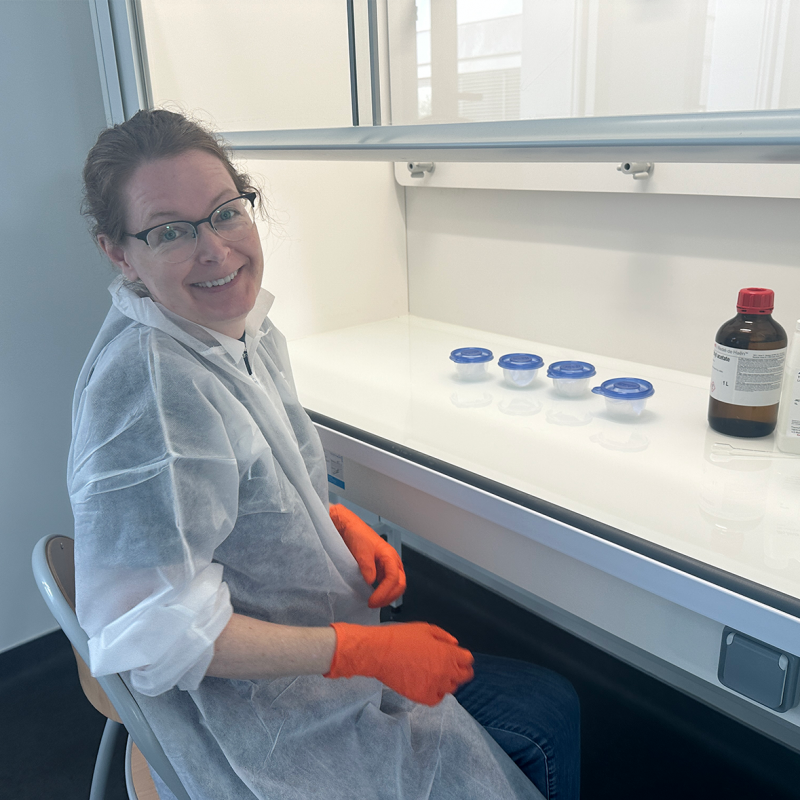
Alison Onsite prepares supplies for the lab at CPE-Lyon. (Photo: Jennifer Leavey)
Culture meets science abroad
The instructional team designed the lab to be inquiry-based. During the three-week course, the students read literature on the biology of silk production, formulated their own research questions about the process, and designed experiments to test their questions.
“The ideas that the students had for their independent projects were so ambitious and inspiring,” said Onstine. Using various lab techniques taught during the class, the students explored how things like temperature, age, and diet impacted the silk proteins produced, the genes expressed by the worms, and more. “It was an incredible experience and an incredible group of students who were able to work with us to develop this lab course in ways that we hadn’t anticipated at the start.”
“I really loved having this class over the summer, especially in Lyon, because we were kind of the ‘guinea pig’ lab for doing it on the study abroad program,” said Biology undergraduate Sonali Patel. “We had the chance to take the reins on our own experiments, so that was really exciting. And especially working with the silkworms in the silkworm capital of France — that was also very exciting because we’re kind of working with the environment, not just some random experiment.”
“This is the birthplace of silk growing and the silk industry in Europe,” echoed Ebrahim Faizullabhoy, a Biology undergraduate and teaching assistant for the class. “So, it feels like you’re doing something that’s directly applicable, doing it in the place where it originated.”
The course is being offered again next summer, and is expected to continue to grow.
“It is sometimes challenging for GT students to find study abroad programs that offer laboratory courses that are required for their degree program,” says Cameron Tyson, principal academic professional in the School of Chemistry and Biochemistry, assistant dean of Academic Programs in the College of Sciences, and director of the BEST-Lyon program. “Over the past 10 years, we have continued to develop and expand course offerings in Lyon so that students can make timely progress towards their degree while also learning about history, culture, and economic activity of the region.”
“Linking a laboratory course to place-based concepts is unusual,” adds Leavey. “We hope that this will enhance learning, excite the students about conducting research, and make their study abroad experience special.”
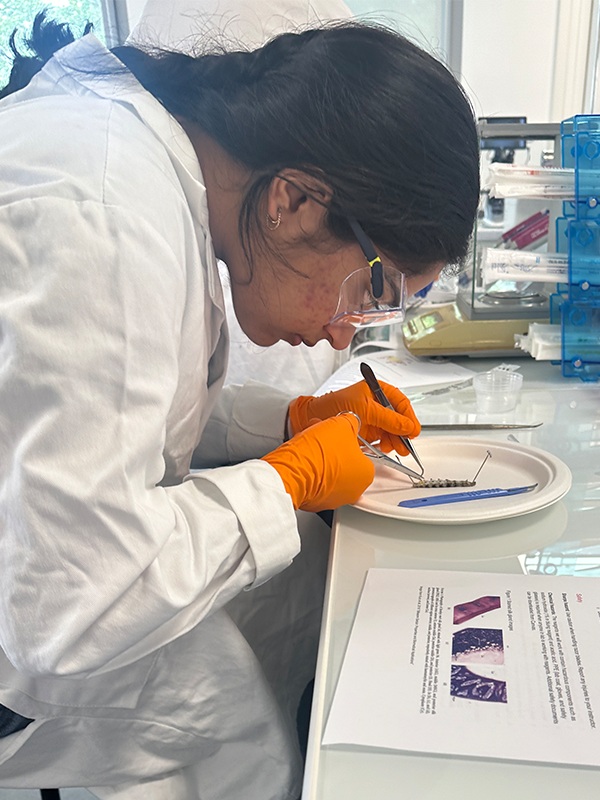
Biology undergraduate Sonali Patel dissects a silk worm to investigate the glands that produce silk and other proteins. (Photo Jennifer Leavey)
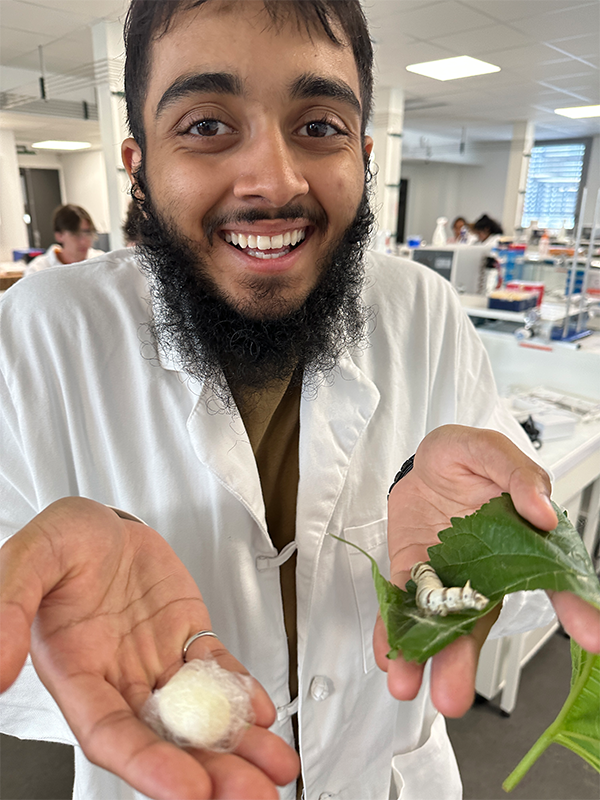
Ebrahim Faizullabhoy, a Biology undergraduate and teaching assistant for the class, holds up a silkworm cocoon and a silkworm atop a mulberry leaf, the silkworm's main source of food.
Apply to the BEST-Lyon Program
Georgia Tech undergraduates are invited to apply for the Biomolecular Engineering, Science, and Technology (BEST) Study Abroad Program in Lyon, France. The BEST-Lyon program combines study at Georgia Institute of Technology, the premier science and engineering institution in the southern U.S., with a summer experience at CPE-Lyon University, a university rich in history in the chemical sciences, engineering, and technology. Participants can explore the inventions of Louis Pasteur, Victor Grignard, Pierre and Marie Curie while studying in France's "second-city", Lyon.
The program is expected to run from mid-May to July, 2024. Learn more about education abroad and apply by February 15, 2024.
_____________________________________
Source of article: College of Sciences website.
